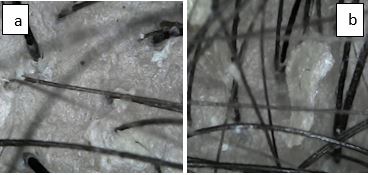A comparative clinical study to evaluate the efficacy of Malatyadi Taila Shiro Abhyanga over Dhurdhuradi Taila Shiro Abhyanga in the management of Darunaka (Dandruff)
DOI:
https://doi.org/10.21760/jaims.8.6.2Keywords:
Darunaka, Ksudraroga, Shiro Abhyanga, Dandruff, Malassezia fungus.Abstract
Great individual cleanliness is critical for both well-being and social reasons. Among maintaining great individual cleanliness hair cleanliness is most imperative and necessary too. Darunaka aka dandruff, also known as Pityriasis Captitis, is one of the foremost common and widely seen dermatological maladies that influences most of the world's populace. The cardinal symptoms for Darunaka are Daruna (rough/flakes), Kandu (scalp itching), Rukshata (dry scalp), Kesha Bhumi Prapatana (cracking of the scalp), Kesha Chyuti (hair fall). A clinical study was conducted to assess the comparative effect of Malatyadi Taila over the Dhurdhuradi Taila Shiro Abhyanga in Darunaka (Dandruff). 40 patients with Darunaka were taken and randomly divided into 2 groups consisting of 20 patients in each group such as Dhurdhuradi Taila as Group A and Malatyadi Taila as Group B. The oil application (Shiro Abhyanga) is adopted for both the Taila with a duration of 1 month. Grading of severity were given for clinical signs and symptoms based on the before and after treatment. The overall effect of the study showed 25% of complete cure, 65% of mild cure and 10% of them have felt no change in Group A, and in Group B 80% of complete cure, 15% mildly cure, and 5% have felt no change. Darunaka management certainly benefited from the usage of Malatyadi Taila. There was a substantial improvement in clinical symptoms after just one month, and it was cost effective, adaptable, and safe.
Downloads
References
https://www.wisdomlib.org/definition/kshudraroga
Kaviraj Ambikadutta, Susruta Samhita by Shastri, Chaukhambha Sanskrit Sansthan Varanasi, Vol 1, Reprint 2006,13th chapter, Shloka 34.
Amy J. McMichael and Maria K. Hordinsky, Hair and Scalp Disorders Medical, Surgical and Cosmetic Treatment edited by CRC Press Taylor & Francis Group, LLC,2nd edition 2018, pg 83 and 86.
Ramnivas Sharma, Surendra Sharma, Sahasrayogam, Chaukhambha Sanskrit Pratisthan, Delhi 2004, Taila Prakarana, pg 96.
Kaviraj Govinda das Sen, edited by Prof. Siddhi Nandan Mishra Bhaisajya Ratnavali, Chaukhamba Surbhharati Prakashan, Varanasi, 1st edition 2015, 60th chapter, shloka 140.
Pavana J, Sarada Mahadev Iyer, Keraliya Chikitsa Paddhatih Ayurvedic Educational and Charitable Trust, Tamilnadu, pg 249.
Premavati Tiwari, Dr. Asha Kumari, Vrndamadhava or Siddha yoga edited and translated, Chaukhambha Visvasbharati, Varanasi, 1st edition Vol II 2006
Pavana J, Sarada Mahadev Iyer, Keraliya Chikitsa Paddhatih Ayurvedic Educational and Charitable Trust, Tamilnadu.
Vaidya Shodala, by Sri Indradev Tripathi, Gadanigraha, with Vidyotini Hindi Commentary, Choukhamba Sanskrit Sansthan, Varanasi, Part III 2012
Hiremath Veeraya: A clinical study on gunja taila shiro abhyanga in the management of Darunaka (Dissertation), Hassan RGUHS-2003.
Chakrapanidatta, Chakradatta Chapter 56, Shloka 74, Bhavarthasandipni Hindi Commentary by Sri Jagadishvaraprasad Tripathi, Chaukhamba Sanskrit series, Varanasi; Pg-430.
Nirmala Saxena. Vangasena Samhita or Chikitsa Sara Sangraha. Vol.2 Choukhamba sanskit series office, Varanasi. Adhyay, Kshudra Roga. Chapter 67 Shloka 125-129; Pg-814.
Premavati Tiwari, Dr. Asha Kumari. Vrndamadhava or Siddha yoga,Vol 2. Chaukhambha visvasbharati, Varanasi, Minor Ailments, Chapter 57, Shloka 90-97;Pg 698-699.
Bhisagratna Pt. Sri Brahma sankara Mishra. Bhavaprakasha of Bhavamisra, Vol 2. Chaukhambha Sanskit Bhawan, Varanasi. Kshudrarogadhikar, Chapter 61, Shloka 15-17, Pg 585.















